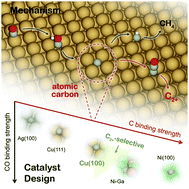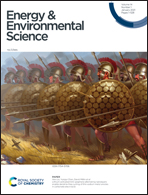The role of atomic carbon in directing electrochemical CO(2) reduction to multicarbon products†
Abstract
Electrochemical reduction of carbon-dioxide/carbon-monoxide (CO(2)R) to fuels and chemicals presents an attractive approach for sustainable chemical synthesis, but it also poses a serious challenge in catalysis. Understanding the key aspects that guide CO(2)R towards value-added multicarbon (C2+) products is imperative in designing an efficient catalyst. Herein, we identify the critical steps toward C2 products on copper through a combination of energetics from density functional theory and micro-kinetic modeling. We elucidate the importance of atomic carbon in directing C2+ selectivity and how it introduces surface structural sensitivity on copper catalysts. This insight enables us to propose two simple thermodynamic descriptors that effectively identify C2+ selectivity on metal catalysts beyond copper and hence it defines an intelligible protocol to screen for materials that selectively catalyze CO(2) to C2+ products.



 Please wait while we load your content...
Please wait while we load your content...